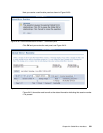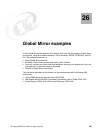
Chapter 25. Global Mirror performance and scalability 339
Figure 25-3 on page 339 proposes spreading the B and C volumes over different ranks at the
remote storage disk subsystem.
Figure 25-3 Remote disk subsystem - all ranks with equal numbers of volumes
The goal is to put the same number of each volume type into each rank. As volume type here,
we refer to the B volumes and the C volumes of the Global Mirror configuration. To prevent an
unbalanced configuration, spread busy volumes over multiple ranks. Otherwise, hot spots will
be concentrated on single ranks when you put the B and C volumes on the very same rank.
The authors recommend that you spread B and C volumes as shown in Figure 25-3.
Another aspect would be to focus on very busy volumes and keep these volumes on separate
ranks away from all the other volumes.
With mixed disk drive capacities, and different speeds, consider spreading B volumes not only
over the fast disks, but also over all ranks. Basically follow a similar approach to that in
Figure 25-3. You can keep particular busy B volumes and C volumes on the faster disks.
Figure 25-4 on page 340 shows, in addition to the three Global Mirror volumes types, the D
volumes, which can be created once in a while for test or other purposes. Here we suggest,
as an alternative, a rank with larger and perhaps slower disks. The D volumes can be read
from another host, and any other I/O to the D volumes does not impact the Global Mirror
volumes in the other ranks. An option here might be to spread all B volumes across all ranks
again, and also configure the same number of volumes in each rank.
Remote siteLocal site
Primary
Primary
A
Secondary
Primary
Primary
Tertia ry
PENDING
Primary
Primary
A
Secondary
Primary
Primary
Tertiary
PENDING
Primary
Primary
A
Secondary
Primary
Primary
Tertiary
PENDING
Primary
Primary
A
Primary
PENDING
Primary
Primary
A
Primary
PENDING
Primary
Primary
A
Primary
PENDING
Host
channels
Rank 1
links
FCP
FICON
FCP
A1
A2
A3
B1
B2
B3
C1
C2
C3
Rank 2
Rank 3
Rank 1
Rank 2
Rank 3
Host


















